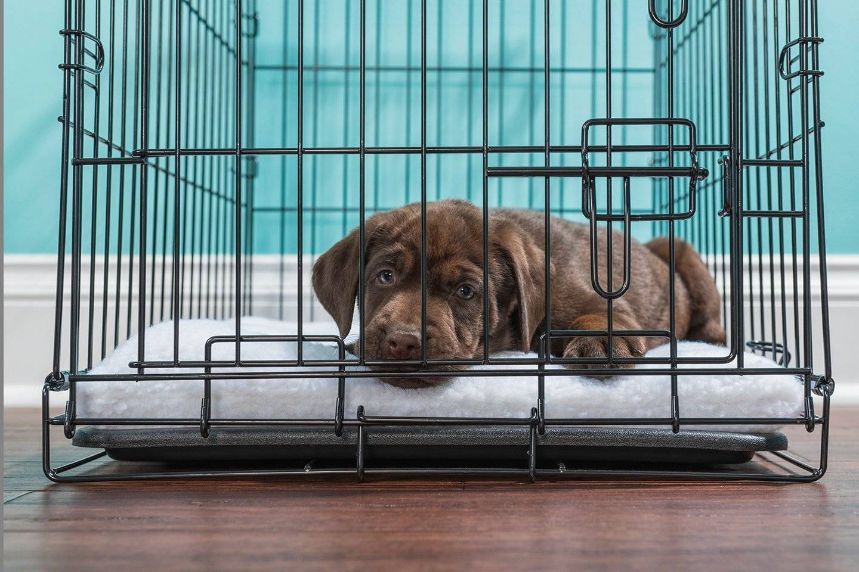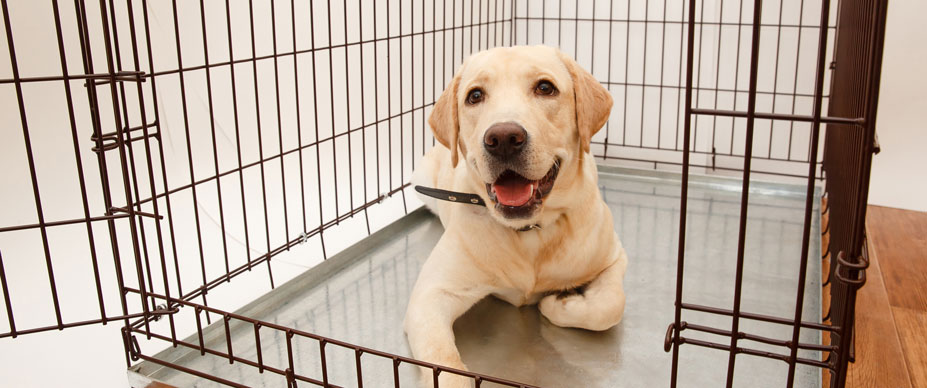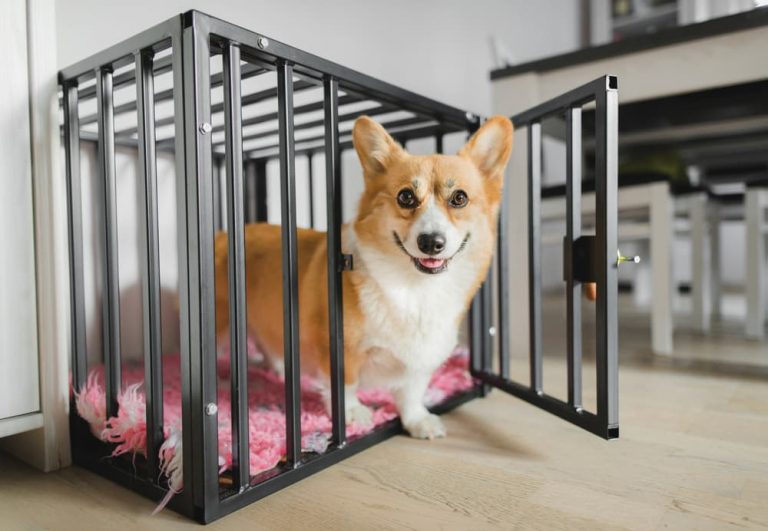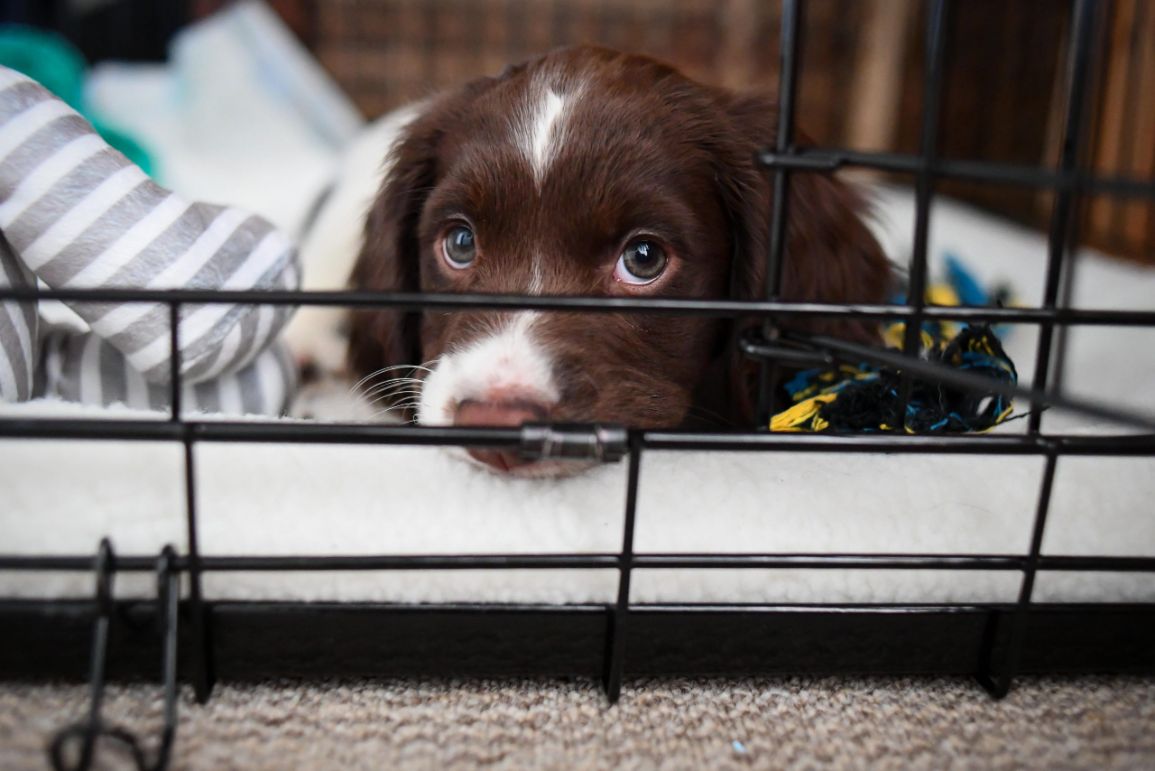When used properly, a crate is an excellent tool for managing and training your dog while also providing a secure area for your dog to retreat to when she’s feeling worn out or anxious. Destructive behavior, chewing, irrational barking, and house soiling can all be ruled out with practical crate training. However, how do you housebreak a puppy? Please keep reading.
What Is Crate Training?
Fundamentally, a crate creates a cozy space that helps your dog feel more secure while being a great short-term method for training and managing your dog. Additionally, it can be useful for restricting access to specific areas of the house as needed and for potty training.
It may take some time and effort to crate-train a puppy, but there are advantages for dog owners as well. You can take your dog on trips with you in safety by using a crate. Additionally, you can successfully house-train your dog in a crate with one to keep her from being destructive when you’re not around to watch.
When Should I Start Puppy Crate Training?
If you’re using the crate for house training, remember that it’s a temporary tool. Your objective is to raise a dog that can be trusted with at least some freedom in your home while you’re away. Once that’s been done, you can simply remove the door or leave it open to keep the crate for your dog to sleep and relax in.
Younger dogs may be easier to train, but with the right approach, you can teach dogs of all ages to feel secure in their crates.

What Will You Need To Crate Train Your Puppy?
You must get a suitable crate that is the right size for your puppy before you begin the crate training process.
Your puppy should be able to sit, stand, turn around, and stretch out comfortably inside the crate. The crate shouldn’t be so large, though, that the puppy feels tempted to use one end as a place to go potty and the other as a sleeping area.
A wire or plastic crate is what you should use ideally. Those crates are straightforward to put together, portable, foldable, and tooth-resistant. After completing the crate training procedure, you can advance to a furniture crate or a soft-sided fabric crate.
Set Up The Crate
Set up the crate with a cozy mat or bed and a crate liner to prevent the bed from slipping.
Some dogs prefer to keep their crates covered to create a den-like environment. Although a loose blanket that might pose a choking risk to your puppy is preferable to a properly fitted crate cover, we do not advise using one. You should also add some treats, a chew toy, and a water bottle for the crate.
You must keep a supply of sweets on hand! So that you can give your puppy a tasty treat and lots of praise right away after he relieves himself in the desired location, keep them on hand.
How To Crate Train A Puppy?
As with many training methods, finding ways to ensure your dog enjoys her space is essential to getting her used to the crate.
Introduce Your Dog To The Crate
It’s time to introduce your dog to the space, and this should be done very gradually once you’ve chosen a crate and set it up as a cozy little den for your canine friend. “You can start getting your dog comfortable with her crate by offering her yummy treats or her meals inside the crate,” Nastanski suggests.
Reward Your Dog
Keep the door to your dog’s crate open so she can access it at all times. “Many dogs will choose to rest inside their crates even when they don’t have to,” Nastanski points out.
Over a few days, begin rewarding your pup when she goes into her crate on her own—it helps to have goodies like cut-up chicken, cheese, or regular ol’ dog treats ready in advance. In order to help your dog adjust to longer crate stays, Nastanski also advises filling two or three puzzle toys with dog-safe foods like plain yogurt or peanut butter.
Prep Her For Crate Time
Prior to time in the crate, always exercise your dog. We advise 30–60 minutes of aerobic exercise but consult your veterinarian before beginning to ensure the activity is safe and suitable for your dog.
Also, avoid boring or monotonous exercise. Instead, choose activities like hiking or practicing on an agility course that will challenge both your dog’s mind and body. Younger dogs can’t hold it as long as adult dogs can, so taking your pet outside for a potty break before crate training is also crucial.
Give Her Something To Do
Continue to give your dog treats while she is in the crate and always leave something for her to chew on (ask your vet what kinds of things are okay for her to chew on when she is left alone). She will grow to love the space as you give your dog treats for entering her crate.

Practice Leaving Your Dog Alone
Work on closing the door and stepping out of the room or house for brief intervals while she is in the crate. As you get better at doing this, start extending your absences until she is comfortable with you being gone for a few hours at a time.
Start Letting Her Roam
When your dog has gone a month without any accidents inside the house and only chews what she’s actually supposed to chew on, it’s a good time to give her some more freedom while you’re away. “But,” Nastanski notes, “the right time to give your dog more freedom will depend on her individual personality.”
Leave the dog’s crate door open if you plan to run to the store for 30 minutes. Start leaving her alone for long stretches of time if everything is calm when you come back, and keep doing so until she is an expert at staying at home alone.
How Do You Make A Schedule For Crate Training A Puppy?
Your lifestyle will determine how frequently you use the crate. For instance, a weekday schedule might be based on your work or school schedule, whereas a weekend schedule might provide more flexibility. It may be difficult to crate-train a smaller puppy who needs more frequent bathroom breaks if you work a full-time job that keeps you away from the house all day. On weekends, when you can spend more time at home, you can still work on housebreaking a puppy.
Here are examples of weekday and weekend training schedules that you can adjust to suit your lifestyle:
Sample Weekday Schedule
- 12 to 16 weeks of age
Dogs should be crated for two hours during the day and six hours at night. - 4 to 5 months of age
For three hours during the day and eight hours at night, crate your dog. - 6 to 7 months of age
Four hours during the day and eight at night should be spent crating your dog. - 8 to 11 months of age
Six hours during the day and eight hours at night should be spent crating your dog. - Over 12 months of age
Dogs should spend eight hours a day and ten hours a night in crates.
Sample Weekend Schedule
- Friday
Leave the crate door open on Fridays when you are home. Treat your dog when he approaches the crate on his own after you’ve thrown treats into it at random intervals. Additionally, you must give your dog his dinner inside the crate. - Saturday
Start using verbal cues with your dog on Saturday, beginning with a practice exercise where you will say the cue, such as “crate,” and then toss in a treat. Take a break after performing the exercise about 10 times. Repeat this exercise at least three times throughout the day and evening. - Sunday
Your dog will start learning how to spend longer periods of time in the crate on Sunday. Give your dog his customary cue to get him into the crate and leave him there for at least 30 minutes starting in the morning. Ensure that he has a chew toy or bone inside so that he has something to keep him busy. Release him from the crate after the allotted time has passed, but refrain from giving him any treats.
Do’s And Don’ts Of Crate Training
These dos and don’ts can assist you in the crate training process because it has both advantages and disadvantages.

- DO attach a water bottle to your dog’s crate when it needs to be created for more than two hours. A bowl could be used as well, but it might be messy.
- Don’t crate train a dog with separation anxiety or other fears and phobias—she might panic, cry, and harm herself while trying to escape the crate. If your dog is anxious or afraid, Nastanski urges you to talk to a professional about it.
- DO stay mindful of the amount of time you leave your dog in her crate. The maximum time is 30 to 60 minutes for an 8 to 10-week-old puppy because puppies and younger dogs don’t have as much bladder control. Dogs’ bodily processes and elimination slow down while they are sleeping, which explains why many adult dogs are capable of sleeping through the night without getting up. Use the information below as a general guide for the maximum crate time to keep your dog healthy and content. Always make sure you have a scheduled time when your dog is let out of the crate to break up the day if you have to crate your dog while you are at work.
- 8–10 weeks old: 30–60 minutes
- 11–14 weeks old: 1–3 hours
- 15–16 weeks old: 3–4 hours
- 17+ weeks old: 4–5 hours
- Don’t use your dog’s crate as a form of punishment. “It’s fine to use the crate sparingly as a brief time-out place,” Nastanski says. “But to offset any potential negative associations, your dog should have a lot more enjoyable experiences with her crate with treats, puzzle toys, and meals.”
- DO let your pup out of the crate if you suspect she has to go potty. Young puppies in particular struggle with this because they can’t stay asleep all night without getting up to use the restroom.
- Don’t use force to remove or put your dog into her crate. Simply lure your dog in and out of the crate with treats or toys to keep it a happy place for her.
Does My Puppy’s Crate Need To Be Closed At Night?
You should secure your dog’s crate at night. If you leave the door open, the puppy might be able to relieve himself wherever and whenever he pleases while also chewing up your belongings.
Additionally, puppies can get into all sorts of trouble when left unattended, endangering your puppy. Regardless of how diligently you work to make your home puppy-proof, that inquisitive little ball of fluff will almost certainly discover electrical cables, household cleaners, your medications, and countless other dangerous items.
Puppies have a tendency to cram into small spaces and even fall out of open windows, sometimes with disastrous results. Therefore, for his safety, keep him inside the crate at night.
Faqs
How Long Is It Safe To Keep A Puppy In A Crate?
The general rule for figuring out how long you can leave your puppy in his crate is his age in months plus one. Therefore, a two-month-old puppy can only spend a maximum of three hours in its crate. Your puppy can stay in his crate for seven hours if he is six months old.
Please take note that this formula is only a suggestion. If your dog is having trouble holding it, be understanding and take him outside for a bathroom break sooner.
My Puppy Is Whining In His Crate. Should I Ignore Him?
Yes, initially. As they get used to being alone, puppies frequently whine in their crates during the early stages of training. Observe your new baby and see if he settles down. Even though many of us want to comfort or console a crying puppy, fight the urge to pay attention to him as he cries.
He will learn that calmness and freedom from the crate go hand in hand if you release him after he has been quiet for a while.
Where Should A New Puppy Sleep On Its First Night?
He can begin sleeping in his crate at night right away, and knowing what to put in your puppy’s crate at night aids in his transition. Or you could put a lidless plastic storage container the right size next to your bed and let him sleep inside of it.
This alternative makes it simple to reach in if he worries at night. Assuring him that you are nearby and that he is not alone in the world is all you should do; you don’t want to play with him in the middle of the night.
Conclusions
To make your schedule easier to follow, you should create one that fits your family’s daily routine. The schedule will be based on your puppy’s need to go potty approximately every two hours, and a regular feeding schedule will help you anticipate when your puppy needs to go.
Remember that the ASPCA advises against crate use until your dog has recovered if he displays vomiting or diarrhea.
Read More: How To Leash Train A Puppy? Tips





